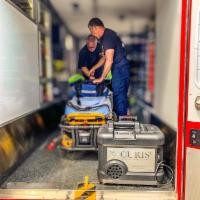CURIS Portable Foggers—Ambulance Disinfection has Never Been Easier
While we often hear of the COVID-19 pandemic’s effects on hospitals, another integral part of the medical infrastructure is frequently overlooked—ambulances and emergency medical service (EMS) personnel. These frontline workers are the boots on the ground when they are needed most, especially as variants of the COVID-19 pandemic continue to impact the world.
Why should you regularly disinfect ambulances?
COVID-19 is not the only concern, however, as EMS workers can be exposed to a variety of dangerous pathogens daily. Due to the wide range of transported patients and the sometimes-frenzied response of emergency care, surfaces within ambulances can become contaminated with dangerous and potentially resistant pathogens. These might be bacteria, viruses, or fungi that can then be transmitted to personnel or future patients from surfaces or hands that have touched contaminated surfaces. One recent study found that 49.9% of swab samples collected in an ambulance tested positive for bacteria.1 The National Association of Emergency Management Technicians (NAEMT) found that approximately 18% of EMS personnel had contracted the SARS-CoV-2 virus as of April 2021.2 The prevalence of Methicillin-Resistant Staphyloccocus aureus (MRSA) among EMS personnel is reported to be four times the rate seen in the general population.2
Common Cleaning and Disinfection Methods
The most common method of ambulance disinfection is using a spray disinfectant and wiping the surface to remove contaminants. A major challenge with this manual process is that it carries the opportunity for missing areas that could be contaminated or for spreading contamination to previously clean surfaces. A study evaluating manual disinfection found that 57% of surfaces contaminated before cleaning turned into 86% afterwards due to the spread of germs.1 Manual cleaning can also expose emergency personnel to organisms, increasing the risk for infection. Many of these spray and wipe chemicals can leave residues behind that allow pathogens to adhere to the surface and should be avoided when possible. In some cases, residues have been found to be corrosive to ambulances, as is the case with chlorine dioxide disinfection.
Clearly, better solutions are needed to protect both EMS personnel and their patients. For this purpose, a number of no-touch technologies exist; however, some are better suited than others. Ambulance fogger systems, for example, can be capable of penetrating around equipment and into compartments. In contrast, the ability of UV lights to disinfect may be affected by both distance from the source and shadows caused by equipment. CURIS’ Hybrid Hydrogen Peroxide (HHP™) foggers overcome those challenges and are compatible with validation methods that provide visible proof that the no-touch disinfection was successful in challenging nooks and crevices.
How do we know CURIS makes a difference for ambulance fogging?
To measure the effect of ambulance disinfection on the workforce, absentee rates Dougherty County EMS were compared to neighboring counties, demonstrating an astounding difference—just 4% for Dougherty County EMS compared to 37% for its neighboring EMS, despite Dougherty County having one of the highest rates of COVID in the nation at that time. Request our case study.
With CURIS System, Decontaminating Ambulances Has Never Been Easier
CURIS System makes decontaminating ambulances and first responder vehicles simple.
- Portable: The 36-pound CURIS Fogger can be placed in either the cab or the box of the vehicle. Its built-in trolley allows easy transport for use in office or bunk spaces as well.
- Safer for use than other caustic chemicals: Operators can “set it and forget it,” without the need to stay in the contaminated space, reducing human exposure to pathogens.
- Thorough: Since the fog penetrates all spaces of the vehicle, frequently used equipment such as stethoscopes and sphygmomanometers (blood pressure cuffs) that may be contaminated can be fogged within the vehicle.
- Versatile: The CURIS Fogger provides the ability to either fog the whole vehicle or use a hand sprayer to target specific surfaces, even the outside of the ambulance.
Benefits of the CURIS System
Traditional spray and wipe methods do not allow for validation to verify if the disinfection treatment was effective. With CURIS System devices, disinfection can be easily validated by introducing pre-packaged spore-carrying biological indicators which will show if this hardy organism was killed with the fog. Inactivation of this difficult-to-kill microorganism tells us that easier-to-kill pathogens such as viruses would likewise be targeted. Chemical indicators can be used to show that the HHP™ fog reached surfaces throughout the ambulance, and adenosine triphosphate (ATP) swabs can be used to measure the “cleanliness” of its surfaces. Since the CURIS System uses a hydrogen peroxide-based solution, HHP™ fogging leaves no harmful chemical residues that can cause pathogens to stick to surfaces.
Conclusion
EMS personnel work tirelessly to deliver lifesaving care to critically ill patients and transport others in need of medical attention. It is crucial that ambulances can be safely and effectively disinfected in a short time frame in between calls or at the end of a shift. These first responders should be able to focus on providing the best care possible for patients without worrying about their own safety. This is where CURIS System provides quick turnaround times while still achieving efficacious kills on even the hardiest organisms. Implementing a no touch disinfection system in ambulances can increase safety for both personnel and patients and increase staff confidence in their workplace.
Try CURIS Today
For more information about how CURIS System can help in your search for the ideal ambulance fogger, please CONTACT US or call 1-800-928-8708, and one of our sales representatives will be happy to speak with you.
1) Taylor-Robinson, A. W. (2019, July 19). Contamination of emergency medical vehicles and risk of infection to paramedic first responders and patients by antibiotic-resistant bacteria: Risk evaluation and recommendations from Ambulance Case Studies. IntechOpen. Retrieved October 7, 2021, from https://www.intechopen.com/chapters/68207.
2) NAEMT. (2021, April). How covid-19 has impacted our nation’s EMS agencies. Our Nation's EMS Agencies. Retrieved October 7, 2021, from https://www.naemt.org/docs/default-source/covid-19/covid-impact-survey-06-03-2021.pdf?sfvrsn=c62fea93_4.
